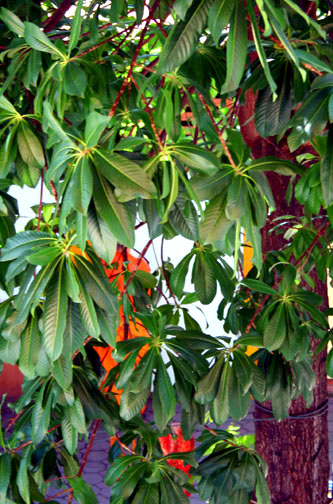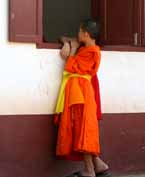Tags
Hunting monks is one of my favorite pastimes. Like most who engage in the sport, I’ve narrowed down my choice of species. I tend to only hunt Buddhist monks. I prefer their bright saffron plumage over the drab coloring of Christian monks, and enjoy the warmer temperatures of the locales they prefer. Monks in other parts of the world tend to migrate during the colder winters months; Buddhist monks remain in their natural habitat making hunting them in SE Asia that much easier and more enjoyable.
Any time, any place within a Buddhist country it’s likely you will find monks. Okay, I can’t recall ever spotting one at night around Patpong, but other than that you have a decent chance of running across one on any street in SE Asia. Capturing a monk in its native habitat is the true goal, sighting the occasional stray monk at a shopping mall, airport, or in a taxi can be exciting, but nowhere near as satisfying as observing them while they are performing their intricate social customs in a natural setting. Since I understand monk hunting is becoming a more popular sport these days – and even heard it is being considered as an Olympic event for 2016 – I thought I’d share my vast years of experience and offer some of the tips and techniques I’ve found that may make your monk hunting efforts a more rewarding experience.
As the numbers of monk hunters increases, there is growing concern about the impact on the monks and their habitat. Monk hunting etiquette is evolving in response to this concern. Some examples of proper monk hunting etiquette include promoting the welfare of monks and their environment, avoiding stressing the monks by limiting use of photography, keeping back from nesting colonies of young monks; and respecting private property during your hunt. It is incumbent upon all monk hunters to observe these traditions to ensure the species’ survival so that monk hunters of the future too may enjoy this popular sport. Here are a few specific unwritten rules – that now have been written – that all monk hunters should follow to assist in protecting this pastime for decades to come:

Historically, monk hunting was a sport of the upper-class and royalty. Today it is enjoyed by all classes (except the monastic one).
First and foremost, the ethical considerations of monk hunting must be taken into account. The principles of fair chase have been a part of hunting traditions for over one-hundred years. The role of the hunter-conservationist, popularized by Theodore Roosevelt, has been central to the development of the modern fair chase tradition in monk hunting. Monks, especially younglings, are not as adept at protecting themselves as other game and it is incumbent upon the monk hunter to observe proper protocol. Techniques may vary depending on government regulations, a hunter’s personal ethics, local custom, and the age of the monk being hunted. The following hunting methods used primarily in monk herd size management are considered inappropriate for amateur monk hunter use:
Baiting: This inappropriate hunting technique involves the use of decoys, lures, scent, or food to entice monks to your area. Note that the giving of alms is not considered a baiting practice except in Luang Prabang.
Beating: This hunting technique should not be confused with monk abuse. It is the use of humans as beaters to flush out monks and/or drive them into an advantageous position for the monk hunter. Novice monks who have been beat by their elders do not fall under this prohibition and may be hunted to your heart’s content because that’s what the Buddha would want.
Dogs: The use of dogs to help flush, herd, drive and track monks is a contentious monk hunting technique. Fortunately most dogs in SE Asia are so lethargic that their use in monk hunting is not generally effective. The use of dogs in monk hunting is up to each individual’s morals but their use to pursue or retrieve monks should always be avoided as is ‘Persistence Hunting’ which is the use of running and tracking to pursue the prey to exhaustion.

Monks are quite adept at the art of concealment, often challenging the skills of even the most advanced monk hunters.
Spotlighting: Using an bright artificial light to find or blind monks gives the monk hunter an unfair advantage and is considered an unethical monk hunting technique. Note that the inadvertent use of such lights, as with the headlights of a local’s hired vehicle at night, is acceptable but often results in a pedestrian fatality and any monk hunter involved with this method may find his monk hunting outing to be quite costly in appeasing the local constabulary.
Camouflage: The use of visual or odor concealment to blend with the environment is an acceptable monk hunting technique and hunters will find paying extra attention to camouflaging their natural scent by regular bathing can pay off immensely much as it does in the related sport of bar boy hunting. Note however that the use of saffron colored clothing to blend with herds of monks is not an appropriate hunting technique and its use can seriously piss of locals in your hunting area.
Driving: Herding monks in a particular direction, usually toward another hunter in your group, is both an acceptable and productive monk hunting technique. Monks are a skittish lot and will take off running whenever they spot a monk hunter in their midst. Using female hunters from your group to direct their flight toward waiting hunters is probably one of the most effective driving techniques available to the modern monk hunter. Some experienced monk hunters have also reported great success by having drivers wear yellow shirts.

Like the young of other prey, novice monks often appear in small groups which allow the monk hunter to quickly reach his daily bagging limit.
Stalking: Sometimes referred to as still hunting, this acceptable monk hunting technique is the practice of walking quietly in search of monks, or in pursuit of an individual monk. It is usually combined with using tracking skills to hone in on monks on the move. The biggest obstacle to using this technique is that locals, in an effort to protect their monk population, will often block your passage by walking in front of you at a slow pace to allow the monk a chance to get away. The judicious use of throwing worthless coins on the ground will usually break up this blockage and allow you ready access to the passageway you are using to stalk your monk.
Chumming: There is a fine line between the established monk hunting technique sometimes referred to as ‘giving alms’ wherein the hunter stands quietly hands filled with rice outstretched waiting for a foraging monk to nibble, and those who use these feeding periods to lure masses of monks by throwing large handfuls of rice into the street. Scholars who have studied the historical basis for monk hunting techniques believe this practicer was borrowed from breeders hunting Thai gogo girls by throwing large buckets of ping pong balls into bars. Regardless, chumming for monks is considered both an inappropriate and ineffective hunting technique as it will often attract scavengers such as street urchins and the homeless instead of monks.
Bag Limits: Provisions under the law which control how many monks of a given species or group of species can be successfully hunted are called bagging limits, although there are often species of monks for which bag limits do not apply. There are also jurisdictions where bag limits are not applied at all, or are not applied under certain circumstances, such as those where the hunter has paid the appropriate tea money to authorities, or use fees to the local monk authorities. Bag limits may also regulate the size or age of the monks with special attention paid to younger ones. In many cases, bag limits are designed to more equitably allocate harvest among the hunting population rather than to protect monk populations.
Historically, especially on the European continent as well as world-wide during periods of conflict, monk hunting was used as a political means to reduce the population of troublesome monks. With the exception of some remote areas of South America, today monk hunting is not practiced as a blood sport. Instead, monk hunters are usually tourists with many participating in photo-safaris. The synonym “bloodless hunt” for hunting with the use of film and a still photographic camera was first used by the Polish photographer Wlodzimierz Puchalski and has gained popularity thanks to Steve Jobs and his efforts at providing new monk hunting equipment such as the iPhone. This had led to the rise in the number of monk hunters stalking the streets in SE Asia though successful techniques have not yet been well documented for the novice monk hunter. To rectify this oversight, here are several tips that will help make your monk hunting more productive:
As with real estate, location, location, location is all important. Novice monk hunters often make the error of assuming one of the best monk hunting locales is where they nest. In the local language monk nests are called wats. And yes, you can usually find a monk or two in or around their local nesting spot. But you’re just as likely to come up craps as monks have learned the hours hunters are usually out and about and have responded by limiting their appearance to the times of the day when hunters are likely to still be nursing their latest hangover or preparing for their next.
It’s not just about location, but about timing too. And like with most wild game, feeding time is one of your best opportunities to catch monks unaware. Throughout SE Asia you can find this sometimes elusive prey singularly and in small groups at the break of day as the forage for food in those neighborhoods close to where they nest. High noon too is an excellent hour to catch monks as this is the hours most herds feed at their nests; large groups of younglings are often spotted during this feeding period providing the monk hunter an easy opportunity of reaching his or her bagging limit in one shot.

During migration the bright plumage of the SE Asian monk (Monkus buddhistia bangkokan) is easy to spot.
Major waterways too are an excellent place for hunting monks. Like most game, monks are attracted to watering holes and rivers, often making several trips daily to their muddy banks. Many major nesting sites are located along the larger rivers in SE Asia and provide an excellent opportunity for spotting the saffron draped mystics demonstrating their migration patterns. Note however that some local authorities have establish monk hunting free zones – generally clearly marked by signage – that the ethical hunter will avoid using (though setting up a blind nearby is an excellent hunting technique).
Monk hunters differ in the techniques they use while pursuing their prey, with many novice hunters relying on luck and happenstance. Equipment costs can be minimal for those just starting with the sport, and the wide range of skill levels that all produce acceptable results is one of the things that has increased the popularity of monk hunting in recent years. If you are considering taking up this growing hobby your best bet is to just dive in with the equipment you have at hand. After bagging your first monk you’ll undoubtedly be hook as have so many others all around the world.
Happy Hunting!
Related Posts You Might Enjoy:






I once saw a video with similar contents, but from the Thai side describing Farang behavior in Thailand, on youtube, which was funny.
However this this piece is not that funny, or rather not funny, even after reading again I still furrow my brow / knit my brows because I don’t know what to make of it. Bordering on blasphemy.
Well Christian, I would agree with you that finding any of my posts not funny is indeed blasphemous.
In this case it’s possible the premise was better than the execution, but then they can’t all be winners. The daily does of male flesh is supposed to make up for that.